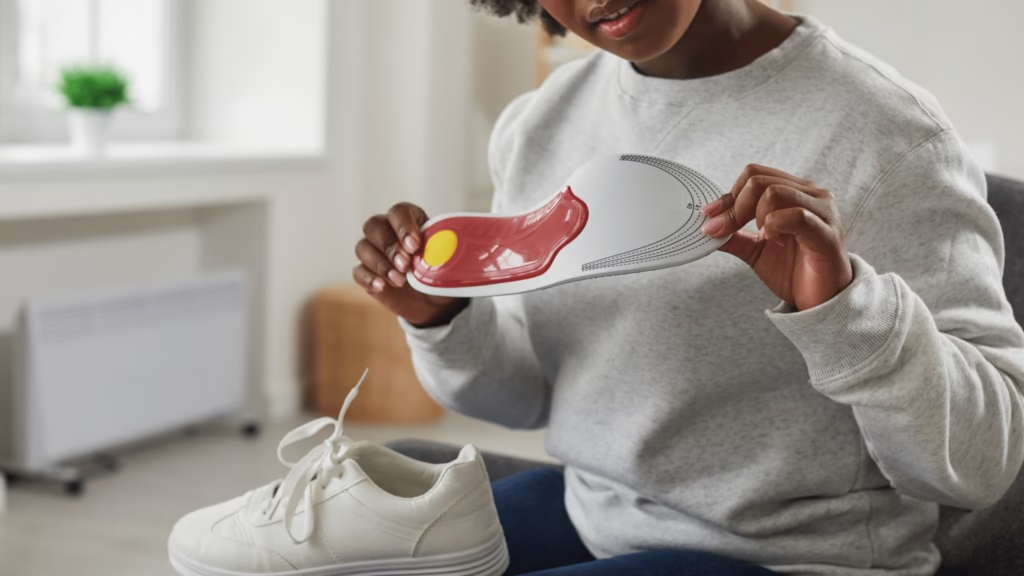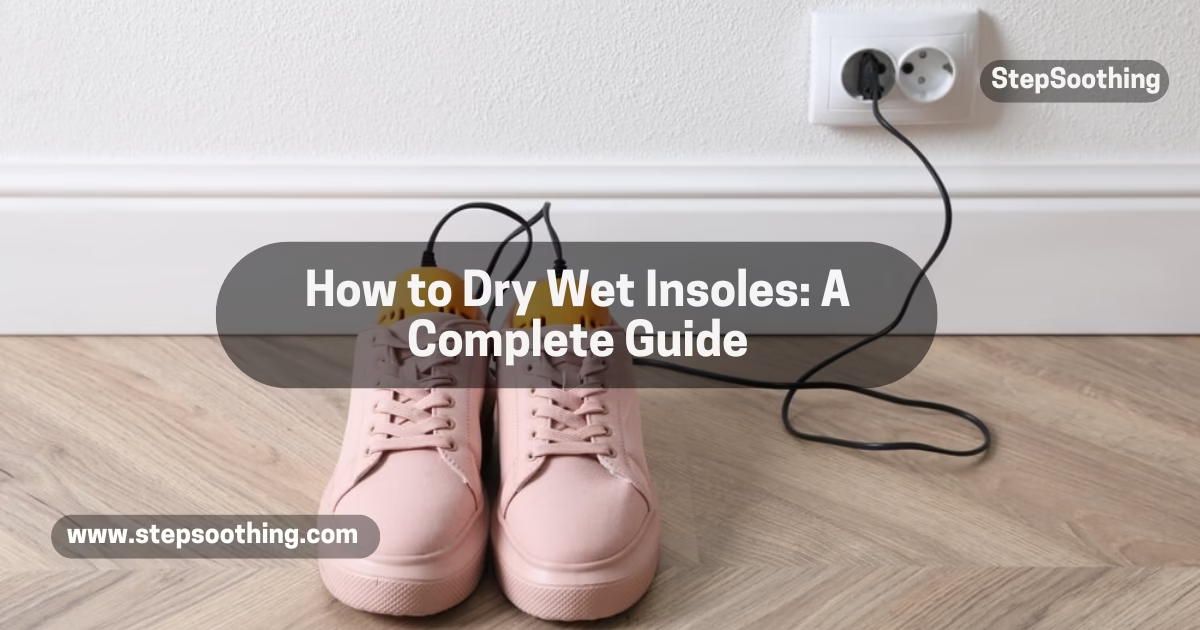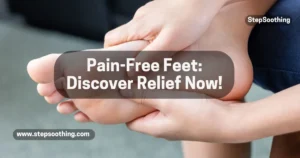Insoles are crucial for the comfort and longevity of your shoes, but what happens when they get wet? Whether it’s from sweating, getting caught in the rain, or stepping into a puddle, wet insoles can cause discomfort and even lead to foot health problems. In this guide, we will cover everything you need to know about drying wet insoles, from the best methods to prevent damage, to how to protect your feet and shoes.
How to Dry Wet Insoles

Why Drying Insoles Is Important
Insoles are not just an afterthought when it comes to footwear—they play a vital role in keeping your feet comfortable, supported, and dry. Wet insoles, if not dried properly, can lead to a range of issues, including discomfort, bad odors, and even fungal infections. Properly drying your insoles is essential to maintain their shape, functionality, and your overall foot health.
Understanding the Materials of Insoles
Not all insoles are created equal, and the material they’re made from will influence the drying process. Understanding the different types of insoles can help you decide the best way to dry them.
Foam Insoles
Foam insoles are one of the most common types used in everyday footwear. They’re soft, comfortable, and absorbent, but also tend to hold onto moisture. When drying foam insoles, you’ll want to avoid high heat, as it can cause the foam to lose its structure or degrade.
Gel Insoles
Gel insoles provide excellent cushioning and support. They’re durable but can be tricky to dry. Because gel can retain moisture for a long time, it’s important to dry these insoles slowly and evenly to prevent damage.
Leather and Fabric Insoles
Leather and fabric insoles are typically found in higher-end shoes. These insoles require gentle drying, as too much heat can cause leather to crack or fabric to shrink. Like foam and gel insoles, these types should be dried gradually to maintain their integrity.

The Risks of Wet Insoles
Wet insoles, while seemingly harmless, can cause more damage than you might realize. Let’s take a closer look at the risks involved.
Foot Health Issues
When insoles stay wet for long periods, they can create an environment perfect for bacteria and fungi to grow. This can lead to unpleasant odors and increase the risk of infections like athlete’s foot. Damp insoles also lose their ability to support your feet properly, which may lead to foot fatigue and discomfort.
Shoe Damage and Odor
Wet insoles can also damage your shoes over time. Moisture that isn’t properly dried can cause mold and mildew to grow inside the shoe, which can deteriorate both the shoes and the insoles. Additionally, moisture can lead to unpleasant odors that are hard to remove.

How to Dry Wet Insoles Safely
Now that we understand why drying wet insoles is essential, let’s explore the best methods to do so safely.
Using a Towel to Absorb Excess Moisture
The first step in drying wet insoles is to blot off as much moisture as possible. Use a clean towel to gently press on the insoles, absorbing any excess water. This helps speed up the drying process without damaging the insoles.
Air Drying: Best Practices
Air drying is one of the safest ways to dry insoles, as it doesn’t involve high heat. Remove the insoles from your shoes and place them in a well-ventilated area. Make sure they are laying flat, not folded or bunched up, to allow air to circulate evenly. Avoid direct sunlight, as this can warp certain materials.
Using a Shoe Dryer or Drying Rack
A shoe dryer is another excellent tool to dry your insoles quickly and safely. These devices circulate warm air through the shoes, helping to dry both the insoles and the shoes themselves without causing damage. If you don’t have a shoe dryer, a drying rack can also help by giving the insoles plenty of room to breathe.
Drying Insoles with Rice or Silica Gel
If you need to dry your insoles quickly, consider using rice or silica gel packets. Both can absorb moisture effectively. Simply place your insoles in a large bag or container with enough rice or silica gel to cover them. Leave them for several hours, and you’ll have dry insoles in no time.

Mistakes to Avoid When Drying Insoles
While drying insoles is easy enough, there are a few common mistakes you should avoid.
Avoid Using Direct Heat or High Temperatures
Heat is one of the worst enemies of insoles. Never place your insoles near direct heat sources like a heater, radiator, or clothes dryer. High temperatures can warp the material, especially in foam and gel insoles, and may cause irreversible damage.
Don’t Leave Insoles Wet for Too Long
Leaving insoles wet for too long can promote the growth of bacteria and mold, leading to unpleasant smells and potential health problems. Always try to dry them as soon as possible after they become wet.

How to Prevent Insoles from Getting Wet
Prevention is always better than cure. Here are some strategies to keep your insoles dry.
Waterproof Insoles
Consider investing in waterproof insoles that are designed to resist water. These are perfect for outdoor activities or wet climates, as they help keep your feet dry even if your shoes get wet.
Protective Sprays and Covers
You can also apply protective sprays or use shoe covers to prevent moisture from seeping into your insoles. These solutions provide a waterproof barrier, especially for outdoor shoes.
How Often Should You Dry Insoles?
If you wear shoes that make your feet sweat or if you live in a wet environment, you may need to dry your insoles more frequently. Aim to dry your insoles after each wear, especially if they’ve become damp from sweat or rain. For high-performance shoes or hiking boots, consider drying them thoroughly after every use.
Conclusion: Keep Your Insoles Fresh and Dry
Drying wet insoles properly is not just about convenience; it’s about protecting your feet, maintaining the lifespan of your insoles, and ensuring your shoes stay in good condition. Whether you use air drying, shoe dryers, or even DIY insole cleaning solutions like rice or silica gel, it’s important to handle the drying process with care. Drying insoles in the right way helps to avoid discomfort, bad odors, and the growth of harmful bacteria or fungi that thrive in damp environments.
Proper care goes beyond drying your insoles. How often to replace shoe insoles depends on how much wear and tear they endure, but maintaining their condition through regular cleaning and proper storage is key. It’s also essential to recognize the signs you need new insoles—such as a noticeable loss of cushioning or discomfort—so you can replace them before they affect your foot health. Additionally, repairing damaged insoles through small fixes or adjustments can prolong their use, but when they are beyond repair, replacing them is a must.
By following these tips for drying, cleaning, and maintaining your insoles, you can ensure that they stay comfortable and functional for longer. This not only improves foot health but also extends the life of your footwear, making them a worthwhile investment. Stay proactive in caring for your insoles to keep your feet happy and supported for years to come.
People Also Asked
Can I use a hairdryer to dry my insoles?
While it’s tempting to use a hairdryer, the high heat can damage the material. Stick to air drying or use a shoe dryer for best results.
How long does it take to dry insoles properly?
Depending on the material and the method used, it can take anywhere from 4 to 12 hours for insoles to dry completely.
Can I leave my insoles outside to dry?
Yes, but avoid direct sunlight, which can damage the materials. Place them in a shaded, well-ventilated area.
Can I dry my insoles in the oven?
No, the oven’s heat is far too intense and could cause irreparable damage to your insoles. Stick to air drying or a shoe dryer.
How can I prevent my insoles from getting wet in the future?
Consider using waterproof insoles or protective sprays, and avoid wearing shoes in very wet conditions without protection.
Learn more:
- Shoes and Insoles: The Influence on Motor Tasks Related to Walking Gait Variability and Stability – PMC
- Wet sneakers and newspaper: A scientific experiment 👟 – Walt Disney World – TouringPlans Discussion Forums
- Carbon Fiber Insoles Enhance Perception of Performance Despite Variable Objective Outcomes: Specific to the Moderately Active Individual – PMC



